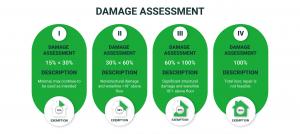How The Disaster Exemption Can Ease The Financial Burden For Homeowners
O'Connor explains the ways in which the disaster exemption can provide relief from financial burdens for homeowners.
HOUSTON, TEXAS, UNITED STATES, May 28, 2024 /EINPresswire.com/ -- The Texas Temporary Exemption for Disaster Damage serves as an important tool to support property owners affected by natural disasters, helping them recover and rebuild their lives and communities. This applies to both businesses and homeowners who have suffered as a result of the disaster.Qualified Property Types
Tangible personal property used for income production
Improvements to real property (this includes the structure or house)
Certain manufactured homes
Determining Exemption Percentage
Once a homeowner applies for the exemption, according to Texas Tax Code 11.35, the chief appraiser of the county evaluates the qualification and then assigns a damage assessment of Level I, II, III, or IV, depending on the amount of damage.
Calculating the Exemption Amount
To clarify how this damage assessment will translate into an exemption amount, here is an example calculation:
John Smith is a hypothetical resident of Montgomery County, where Governor Greg Abbott issued a declaration of disaster on April 30, 2024.
The improvement value of John Smith’s home is $300,000.
Following the recent flooding event, John learned that the cost to repair his home is $65,000.
$65,000 Damage/$300,000 improvement value = 21.7%
John’s 21.7% damage assessment qualifies his damage as Level I, making him eligible for a 15% exemption.
Because the disaster declaration was issued on April 30, this gives a proration amount of 0.61 to account for the portion of the year where the value of John’s home was diminished. The proration amount is arrived at by taking the number of days remaining in the year after the disaster is declared, 223, and dividing by 366 (2024 is a leap year).
Take the improvement value x exemption percentage x proration to determine the temporary disaster exemption amount for John’s house.
In John’s case, it looks like this: $300,000 x 0.15 x 0.61 = $30,150.
This means that $30,150 is exempted from property taxes for the year 2024.
Combining Exemptions
John Smith and other residential property owners finding themselves in a similar situation should gain some sense of relief in the fact that the temporary disaster exemption does not exclude the residence homestead exemption. Texas Tax Code Section 11.135 allows for the homestead exemption to remain in place even when the structure is rendered uninhabitable, while the owner constructs the replacement structure. The caveat to this is the owner may not claim a homestead exemption on a different property. Only one homestead exemption is allowed. The owner must also intend to return and occupy the structure as the principal residence. Similar to the homestead exemption, the elderly or disabled exemption may also be maintained during reconstruction. It is important to note that should a home be improved by either increasing the size or using a higher quality of construction, this may cause the property to be subject to a tax increase.
Apply For and Accept All Available Reductions
Homeowners across the state have faced extreme challenges, however utilizing the Temporary Disaster Exemption is one way to soften the blow. Ensuring all eligible exemptions are in place and annually appealing assessment values is the legal right of Texas property owners. O’Connor is dedicated to helping property owners understand and leverage these rights, in the pursuit of cost-effective tax reduction.
About O'Connor:
O’Connor is among the largest property tax consulting firms in the United States, providing residential property tax reduction services in Texas, Illinois, and Georgia, as well as commercial property tax reduction services across the United States. O’Connor’s team of professionals possess the resources and market expertise in the areas of property tax, cost segregation, commercial and residential real estate appraisals. The firm was founded in 1974 and employs more than 900 professionals worldwide. O’Connor’s core focus is enriching the lives of property owners through cost effective tax reduction.
Property owners interested in assistance appealing their assessment can enroll in O’Connor’s Property Tax Protection Program ™ . There is no upfront fee, or any fee unless we reduce your property taxes, and easy online enrollment only takes 2 to 3 minutes.
Patrick O'Connor, President
O'Connor
+ +1 713-375-4128
email us here
Visit us on social media:
Facebook
X
LinkedIn
YouTube
Legal Disclaimer:
EIN Presswire provides this news content "as is" without warranty of any kind. We do not accept any responsibility or liability for the accuracy, content, images, videos, licenses, completeness, legality, or reliability of the information contained in this article. If you have any complaints or copyright issues related to this article, kindly contact the author above.


